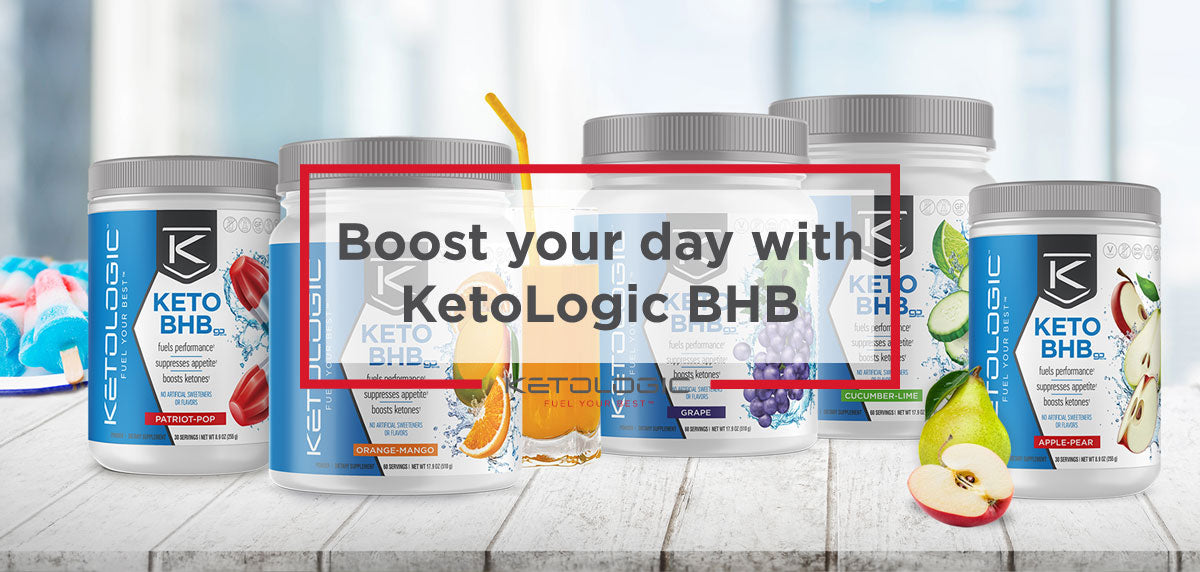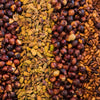The Keto Flu: Your A-Z Guide to Why It Happens and How To Fix It

- Low energy
- Poor concentration
- Nausea
- Diarrhea
- Muscle cramps
- Headaches
- Insomnia
- Constipation
They begin to second-guess themselves, wonder whether keto is right for them, and start thinking about those bagels in the freezer. This is a shame because keto flu symptoms indicate they're about to turn the keto corner, and giving up now means they are throwing away all of the progress they have made just before the best part about keto occurs.The keto flu is common - an estimated one in 12 people who starts the keto diet shows signs or symptoms of the keto flu. But don't despair, it gets better.
What is the Keto Flu?
Also known as the carb flu or low-carb flu, the keto flu is a popular term that describes flu-like symptoms that some people experience in the first few days of starting the ketogenic diet.Keto flu is not actually a flu. It's not contagious and it's not dangerous. But it can definitely be unpleasant.
The discomfort that you're feeling is a natural reaction your body goes through when it transitions from burning glucose to burning fatty acids (ketones) for fuel.
You see, fat is your body’s secondary or backup fuel source, behind sugar or carbohydrates (in the form of glucose) [1]. You will naturally burn fat when there’s not enough glucose in your diet. Once your body has switched over to burning fat, you have officially entered ketosis.
Keto flu symptoms usually set in 3 to 5 days into your diet and can last up to 2 weeks (or longer, in rare cases.) [2]
So what causes the keto flu?
What are the Symptoms of the Keto Flu?
There’s no way to predict whether you’ll experience keto flu symptoms until you start the diet.
If you already eat a healthy diet that's relatively low in processed sugars and starches, you may notice only mild symptoms, or none at all. But if you’re switching from a highly processed, high-sugar diet, you may be more likely to experience “withdrawal” symptoms.
Some of the more frequently mentioned symptoms of the carb flu include:
- Nausea or vomiting
- Constipation or diarrhea
- Headache
- Irritability
- Weakness
- Muscle soreness or cramps
- Dizziness
- Poor concentration
- Trouble sleeping
- Food cravings
If you've been following the typical Standard American Diet (SAD), you're likely used to eating 250g – 350g of carbohydrates, including sugar, every day [3]. When you adopt a ketogenic diet, you’re slashing your carb intake to 25g - 50g per day. That's quite an adjustment.
If that’s you, don’t worry. You’re not alone. The carb consumption problem has gotten more serious over time.
In 1700, the average American was eating about five pounds of sugar per year. But by 1900, our sweet tooth was in full swing and we were consuming upwards of 70 pounds every year. Today, this number has ballooned to more than 100 pounds of sugar annually — that’s more than 40 teaspoons a day. This toxic substance comes by many names — from barley malt to fruit juice — but its effects are clear.
Most Americans now consume so much refined sugar and processed carbs that they are "metabolically rewired" to burn sugar for energy and store the excess as fat. Breaking this cycle can throw your body out of balance and cause temporary fatigue and flu-like systems.
Your symptoms aren’t all in your mind. Lots of science has been done to try and figure this out.
The Science Behind the Keto Flu
There is no scientific consensus on where the keto flu comes from, but there are many theories.Some researchers and doctors believe these side effects of keto can be attributed to one of the following:#1 Keto Flu Cause: Fat Adaptation
There's a period of time between when you have stopped eating your regular carb load, and when your body achieves ketosis. This period is called the fat adaption stage.
During fat adaption, your body is adapting to using fat as energy. It doesn't have enough carbohydrates to use as fuel (albeit cheap fuel), but it also hasn't gotten the hang of switching to using the quality fats you're consuming, either. In the interim, it must still get you around. So your body uses something called "muscle glycogen," which are your glucose stores.
Some research (like this study) suggests that reduced muscle glycogen (because your body is using it for energy) can cause lethargy and mood swings.
#2 Keto Flu Cause: Electrolyte Deficiency
This is the most widely accepted keto flu culprit because almost all symptom-sufferers see significant improvement in their keto flu-like symptoms when they begin to supplement electrolytes (usually with beta-hydroxybutyrate or BHB).That's because when your body is using glycogen to fuel itself, it uses water for this metabolic process and flushes water out of your system. With that water goes the electrolytes your body needs. Electrolytes such as magnesium, calcium, sodium, and potassium are crucial for your body to operate efficiently. When you have an electrolyte imbalance on keto, you experience flu-like symptoms. If you've ever felt sick, sluggish or depleted after a long run in the heat or a day at the beach, or if you've ever experienced a hangover, you'll know what we mean. There are a few other common theories about the cause of the keto flu, but the third and most relevant is insulin levels.
There are a few other common theories about the cause of the keto flu, but the third and most relevant is insulin levels.
#3 Keto Flu Cause: Reduced Insulin Levels
Insulin is a hormone that helps your body absorb glucose from your bloodstream. When you have less glucose in your system, you don't need as much insulin to process it (i.e., to lower your blood sugar levels).
That's why when you switch from a high-carb diet to a diet that’s super low in carbs, your insulin levels usually drop drastically.
That's a good thing. It's one of the main reasons the ketogenic diet is so beneficial. People often notice improved brain function, greater energy, stabilized blood sugar, fewer seizures, and much more.
That’s because when glucose is no longer available as an energy source and your insulin levels are very low, your liver starts converting fat into ketones. Most of your cells can use these ketones in place of glucose for energy.
Once your body is mainly using ketones and fat for energy, you've entered ketosis.
But it takes time for your brain and some of your other organs to adjust to using this new fuel source.
When your insulin levels drop, your body reacts by ridding itself of excess water and sodium (which bind themselves to the glycogen or stored carbohydrates in your system). This is why you may urinate more often in the first week after starting a keto eating plan [5].
This also explains the weight loss that often occurs in the early stages of the diet. You’re mostly losing water weight due to lower sodium levels.
Losing sodium and water weight can actually bring on the unpleasant symptoms of the keto flu.
How to Treat Keto Flu Symptoms
Even though your body is undergoing some significant changes, there's no need to strain or suffer. The symptoms of the keto flu are almost all completely and easily treatable. So what should you do if you're feeling uncomfortable or even downright miserable?
1. Replenish What You're Losing
In a word - hydrate.
Remember that your body is ridding itself of stored water. So you'll need to drink plenty of water to replace what you're losing.
Staying hydrated can relieve both fatigue and muscle cramping.
Replacing your fluids is particularly important if you experience diarrhea, which can dehydrate you quickly.
2. Replenish Electrolytes and Micronutrients
You lose essential micronutrients and minerals when your body sheds excess water, and along with that water often goes electrolytes.
Most new keto-ers are electrolyte deficient and need to supplement electrolytes. This can be done quite easily through beta-hydroxybutyrate (aka BHB or exogenous ketones), which are ketone salts that contain high levels of potassium, magnesium, sodium, and calcium (the 4 cornerstone electrolytes your body needs to function properly). We use a ready-to-use ketone body that is clinically shown to provide a boost to your energy, performance, and focus in KetoLogic BHB Exogenous Ketones. Just 1-2 scoops of Keto BHB or KetoEnergy BHB per day should have you covered for electrolytes.If you find that BHB isn't enough, opt for some Keto Electrolytes. You can also add some coconut or MCT oil to support ketosis. You can also replenish some electrolytes and other essential micronutrients through food (just make sure to eat a lot of them!):
- Potassium - found in avocados, nuts, dark leafy greens such as spinach and kale, salmon, plain yogurt, and mushrooms
- Magnesium - plentiful in nuts, dark chocolate, artichokes, fish, and spinach
- Sodium - salt, soup, broth, bacon, pickles, and sauerkraut
- Calcium - cheese, leafy greens, broccoli, seafood (sardines!), and almonds
- Phosphorus - meats, cheese, nuts, seeds, and dark chocolate
- Chloride - most vegetables, olives, seaweed, and salt
You can also try coconut water. Just be aware that some brands of coconut water add sugar, so check the nutrition facts.
3. Eat More (Yes, Really)
Whatever you do, don't go hungry!
Many people inadvertently eat too little because they feel nauseous. Or they don’t fully replace the calories from the carbs they’ve removed from their diets.
Instead, consume as many keto-approved foods as you want, and keep healthy snacks like hard-boiled eggs and cheese crisps close by to help increase your daily caloric intake.
Add as many of these fat sources to your meals as you can:
- Coconut oil
- MCT oil
- Lard
- Macadamia nut oil
- Olive oil
- Ghee or butter
- Tallow
4. Ease Out of Your Sugar Addiction
If you're having a tough time adapting to the ketogenic diet, you may have to eliminate carbs gradually instead of all at once.
Instead of immediately cutting back to 25g of carbs per day, try easing into a more moderate low-carb diet of 50g carbs per day, while increasing your protein and fat intake [6].
Choose healthier "clean" carbs and not the usual junk found in processed foods. Good carbs and essential micronutrients from fruits and vegetables can help relieve your symptoms as your body adjusts.
5. Take It Easy
If you don't feel like you have the energy for a full workout, don't push it. Allow yourself time to ease into your new lifestyle.
Choose less demanding, moderate exercise, especially in the beginning -- activities like walking, gentle stretching, or yoga might be a good start.
Remember that your body is already under stress adapting to a new fuel system, so don’t place an additional burden on it by forcing a strenuous workout. Listen to your body and gradually increase your exercise intensity over time.
6. Get Sufficient Rest
Lack of sleep can add to your body’s stress, so make sure you're getting enough of it. Slow down and relax, especially at night.
If you're having trouble falling or staying asleep, you may experience relief with:
- An Epsom salt bath
- Sleepytime tea (made from valerian and chamomile)
- A break from devices 2 hours before bed
- Relaxing yoga routines
- Guided meditation sessions
7. Take Exogenous Ketones
Finally, you can manage your flu-like symptoms with KetoLogic BHB — a great tasting and convenient fuel source for those on, or transitioning to, a low-carb or ketogenic diet. Grab some KetoLogic BHB during afternoon energy “slumps” or during exercise to help fuel your mental and physical performance.
Kick Your Keto Flu Symptoms to the Curb
Even though the symptoms of keto flu can be uncomfortable, you'll find that they're both short-lived and worthwhile once you push through them.
Not only will you most likely lose weight, you'll also have more energy, feel less bloated, and experience fewer digestive issues, among other benefits.Keto works, but only if you stick to it.
Don't make your transition more difficult than it needs to be. Listen to your body. If you need to ease into a low-carb diet or take supplements, then do it.
And don't despair if you backslide. Simply take the long view and start again the next day. There’s no room for guilt in your personal journey to wellness.
Once the temporary discomfort of the keto flu has passed, you’ll most likely feel better than ever… and you’ll be glad you stuck to it!
-
Posted in
Authority Article, Keto, Keto Mistakes, Nutrition Article, Starting Keto, Weight Loss




